
The pitohuis are bird species endemic to New Guinea. The onomatopoeic name is thought to be derived from that used by New Guineans from nearby Dorey (Manokwari), but it is also used as the name of a genus Pitohui which was established by the French naturalist René Lesson in 1831. The unitalicized common name however refers to perching birds that belong to several genera of multiple bird families. The genera include Ornorectes, Melanorectes, and Pseudorectes apart from Pitohui.
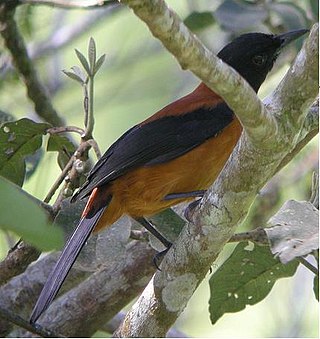
The hooded pitohui is a species of bird in the genus Pitohui found in New Guinea. It was long thought to be a whistler (Pachycephalidae) but is now known to be in the Old World oriole family (Oriolidae). Within the oriole family, this species is most closely related to the variable pitohuis in the genus Pitohui, and then the figbirds.

Batrachotoxin (BTX) is an extremely potent cardio- and neurotoxic steroidal alkaloid found in certain species of beetles, birds, and frogs. The name is from the Greek word βάτραχος, bátrachos, 'frog'. Structurally-related chemical compounds are often referred to collectively as batrachotoxins. In certain frogs, this alkaloid is present mostly on the skin. Such frogs are among those used for poisoning darts. Batrachotoxin binds to and irreversibly opens the sodium channels of nerve cells and prevents them from closing, resulting in paralysis and death. No antidote is known.
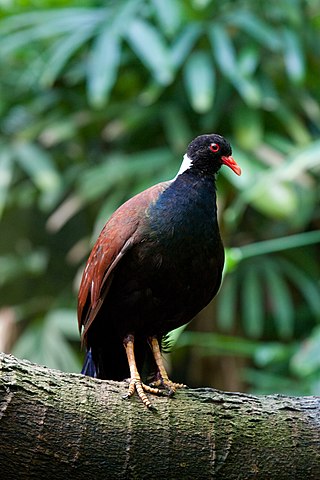
The pheasant pigeon is a species of large terrestrial pigeon. It is the only species of the monotypic genus Otidiphaps. The pheasant pigeon is found in the primary rainforests of New Guinea and nearby islands. It ranges primarily over hilly and lower mountain areas, but can also be found in lowlands.

The rusty pitohui is a species of bird in the family Pachycephalidae. It is found throughout the lowlands of the Aru Islands and New Guinea.

The glossy swiftlet is a species of swift in the family Apodidae. It is found on the Indonesian island of Sulawesi and eastwards to New Guinea, the Bismarck Archipelago and the Solomon Islands.

The grey-olive greenbul, or grey-olive bulbul, is a species of songbird in the bulbul family, Pycnonotidae. It is found in eastern and south-central Africa. Its natural habitats are subtropical or tropical dry forests, subtropical or tropical moist lowland forests, and subtropical or tropical moist shrubland.
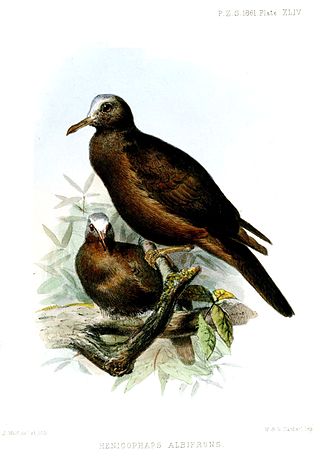
The New Guinea bronzewing is a species of bird in the pigeon and dove family Columbidae. It is found in New Guinea. Its natural habitats are subtropical or tropical moist lowland forests and subtropical or tropical moist montane forests.
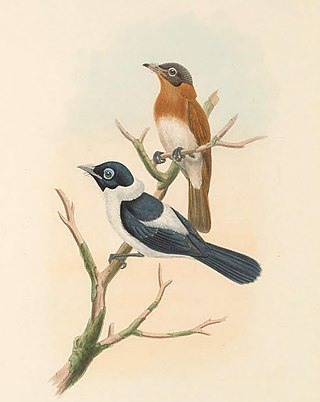
The frilled monarch is a species of bird in the family Monarchidae. As currently defined, its range is restricted to forest on New Guinea and nearby smaller islands, but historically it has included some or all of the remaining members of the genus Arses as subspecies.

The morningbird is a songbird species in the family Pachycephalidae.

The common cicadabird, also known as the slender-billed cicadabird, is a species of bird in the family Campephagidae. It is found in Australia, Indonesia, New Guinea, and the Solomon Islands. Its natural habitats are temperate forest and subtropical or tropical moist lowland forest. The species is placed in the reinstated genus Edolisoma by most authors. The common cicadabird was described as a "great speciator" by Mayr & Diamond (2001); and Pedersen et al. (2018) described how this species rapidly colonized and diversified across the Indo-Pacific island region and Australia in the Pleistocene.

The golden monarch is a species of passerine bird in the family Monarchidae found in New Guinea. Its natural habitats are subtropical or tropical moist lowland forests and subtropical or tropical moist montane forest. The golden monarch displays marked sexual dimorphism, the male a striking golden colour with black mask, wings and tail, the female a golden or golden-olive colour. Both bear a characteristic 'teardrop' white pattern below the eye.

The shining flycatcher is a species of bird in the family Monarchidae. It is found in northern Australia, and from the Moluccas to the Bismarck Archipelago. Its natural habitats are subtropical or tropical moist lowland forest and subtropical or tropical mangrove forest.
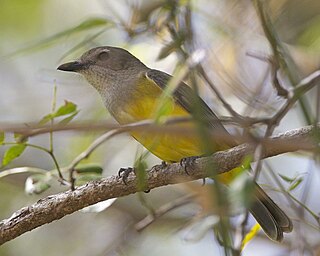
The mangrove golden whistler or black-tailed whistler, is a species of bird in the family Pachycephalidae. It is found in mangrove forests and adjacent wet forests of Papua New Guinea and Australia.

The grey whistler or brown whistler, is a species of bird in the family Pachycephalidae. It is found in northern Australia and New Guinea. Its natural habitats are subtropical or tropical moist lowland forest and subtropical or tropical mangrove forest.

The white-bellied pitohui is a species of bird in the family Pachycephalidae. It is found throughout the lowlands of southern New Guinea (Lorentz River to upper Fly River.

The northern variable pitohui is a species of pitohui in the family Oriolidae. It is found on New Guinea and a number of neighbouring islands. Its natural habitat is subtropical or tropical moist lowland forests. It is also one of the few known poisonous birds.

The black pitohui is a species of bird in the monotypic genus of Melanorectes in the family Pachycephalidae. It is found throughout the highlands of New Guinea. Its natural habitat is subtropical or tropical moist lowland forests.

Pitohui is a genus of birds endemic to New Guinea. The birds formerly lumped together as pitohuis were found by a 2008 study that examined their evolutionary history on the basis of the genetic sequences to have included birds that were quite unrelated to each other. They have since been separated into other genera.

The southern variable pitohui is a species of pitohui in the family Oriolidae. It is found on New Guinea and neighbouring islands. Its natural habitat is subtropical or tropical moist lowland forests. It is also one of the few known poisonous birds, it carries the toxic compound homobatrachotoxins in its feathers and skin.




















